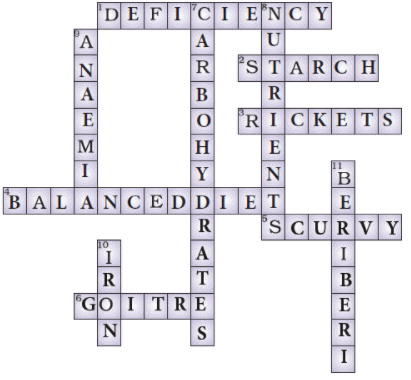NCERT Exemplar Solutions: Components of Food | Science Olympiad Class 6 PDF Download
Multiple Choice Questions
Q1: Which one of the following food item does not provide dietary fiber?
(a) Wholegrain
(b) Whole pulses
(c) Fruits and vegetables
(d) Milk
 View Answer
View Answer 
Ans: (d)
Animal products like milk do not contain dietary fiber.
Dietary fiber is formed of cellulose and is obtained mainly from plant products.
Whole grains, whole pulses, fruits and vegetables are rich sources of dietary fiber.
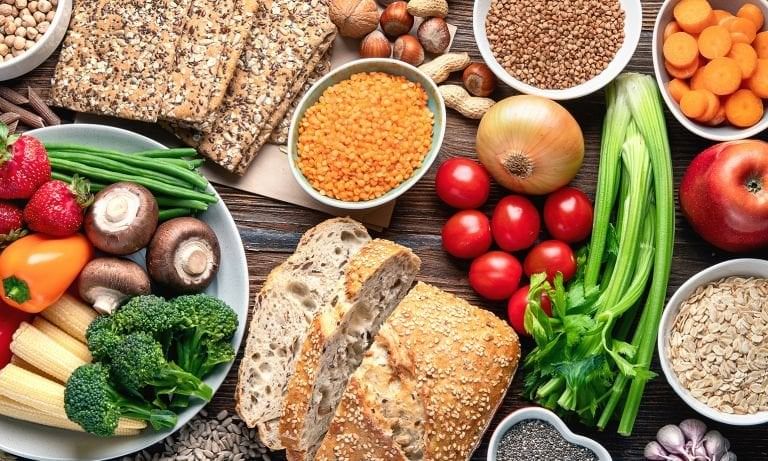 Dietary Fiber foods
Dietary Fiber foods
Q2: Which of the following sources of protein is different from others?
(a) Peas
(b) Gram
(c) Soya beans
(d) Cottage cheese (paneer)
 View Answer
View Answer 
Ans: (d)
Cottage cheese (paneer) is the source of animal protein whereas peas, gram and soya beans are the sources of plant proteins.
Q3: Which of the following nutrients is not present in milk?
(a) Protein
(b) Vitamin C
(c) Calcium
(d) Vitamin D
 View Answer
View Answer 
Ans: d
Vitamin C is present in a negligible amount in milk whereas protein, calcium and vitamin D are present in considerable amounts in milk.
Q4: Read the food items given below.
(i) Wheat
(ii) Ghee
(iii) Iodized salt
(iv) Spinach (palak)
Which of the above food items are “energy-giving foods”?
(a) (i) and (iv)
(b) (ii) and (iv)
(c) (i) and (ii)
(d) (iii) and (iv)
 View Answer
View Answer 
Ans: (c)
Fats and carbohydrates are energy giving foods hence ghee is rich in fats whereas wheat is rich in carbohydrates. So, these are energy giving foods.
Iodized salt and spinach are protective foods because iodized salt contains minerals and spinach is rich in both minerals and vitamins.
Q5: Read the following statements about diseases.
(i) They are caused by germs.
(ii) They are caused due to lack of nutrients in our diet.
(iii) They can be passed on to another person through contact.
(iv) They can be prevented by taking a balanced diet.
Which pair of statements best describe a deficiency disease?
(a) (i) and (ii)
(b) (ii) and (iii)
(c) (ii) and (iv)
(d) (i) and (iii)
 View Answer
View Answer 
Ans: (c)
They are caused due to lack of nutrients in our diet. And they can be prevented by taking a balanced diet. Deficiency diseases are the diseases which are caused by the deficiency of nutrients in the diet. These are non-infectious and do not spread from one to another person.
Q6: Given below are the steps to test the presence of proteins in a food item.
(i) Take a small quantity of the food item in a test tube, add 10 drops of water to it and shake it.
(ii) Make a paste or powder of food to be tested.
(iii) Add 10 drops of caustic soda solution to the test tube and shake well.
(iv) Add 2 drops of copper sulphate solution to it.
Which of the following is the correct sequence of the steps?
(a) i, ii, iv, iii
(b) ii, i, iv, iii
(c) ii, i, iii, iv
(d) iv, ii, i, iii
 View Answer
View Answer 
Ans: (b)
To test the presence of proteins in a food item, first, make a paste or powder of food to be tested (ii), then take a small quantity of the food item in a test tube, add 10 drops of water to it and shake it (i). After that add 2 drops of copper sulphate solution to it (iv), and finally, add 10 drops of caustic soda solution to the test tube and shake well (iii). Let the test tube stand for a few minutes and observe the colour of the solution in the test tube. The appearance of violet colour indicates the presence of proteins in the given food item.
Very Short Answer Questions
Q7: Unscramble the following words related to components of food and write them in the space provided.
(a) reinpot ______
(b) menliars ______
(c) tivanmi ______
(d) bocatradhyer ______
(e) nitesturn ______
(f) tfa ______
 View Answer
View Answer 
(a) Protein
(b) Minerals
(c) Vitamin
(d) Carbohydrate
(e) Nutrients
(f) Fat
Q8: Which of the following food items does not provide any nutrient
[Milk, Water, Orange juice, Tomato soup]
 View Answer
View Answer 
Water does not provide any nutrients to the human body, yet it is essential for life.
Short Answer Questions
Q9: Fill in the blanks from the list of words given below.
(carbohydrate, fat, protein, starch, sugar, vitamin A, vitamin C, roughage, balanced diet, obesity, goitre)
(a) Egg yolk is rich in ______ and egg albumin is rich in ______.
(b) Deficiency diseases can be prevented by taking a ______.
(c) Eating too much of fat-rich foods may lead to a condition called ______.
(d) The component of food that does not provide any nutrient to our body and yet is essential in our food is ______.
(e) The vitamin that gets easily destroyed by heating during cooking is ______.
 View Answer
View Answer 
(a) fat, protein
(b) balanced diet
(c) obesity
(d) roughage
(e) vitamin C
Q10: Read the items of food listed below. Classify them into carbohydrate-rich, protein-rich and fat-rich foods and fill them in the given table. Moong dal, fish, mustard oil, sweet potato, milk, rice, egg, beans, butter, buttermilk (chhachh), cottage cheese (paneer), peas, maize, white bread.
Q11: Tasty food is not always nutritious and nutritious food may not always be tasty to eat. Comment with examples.
 View Answer
View Answer 
Tasty food is not always nutritious like, burger, pizzas, chats, potato chips etc. are very tasty but not nutritious. These foods contain refined flour (Maida), spices and a lot of oil which is not good for health.
On the other hand, nutritious food may not always be tasty to eat like, boiled vegetables, pulses, leafy vegetables etc. are not always tasty but are very good for health. These foods contain important nutrients (proteins, vitamins, minerals etc.) which help us to maintain our body strong and healthy.
Q12: While using iodine in the laboratory, some drops of iodine fell on Paheli’s socks and some fell on her teacher saree. The drops of iodine on the saree turned blue-black while their colour did not change on the socks. What can be the possible reason?
 View Answer
View Answer 
The saree of Paheli’s teacher would have contained starch. When starch is exposed to iodine solution, starch turns into blue-black so the saree also turned blue-black. Paheli’s socks would have not contained starch thus did not show any colour change.
Q13: Paheli and Boojho peeled some potatoes and cut them into small pieces. They washed and boiled them in water. They threw away the excess water and fried them in oil adding salt and spices. Although the potato dish tasted very good, its nutrient value was less. Suggest a method of cooking potatoes that will not lower the nutrients in them.
 View Answer
View Answer 
Potatoes are nutritious vegetables that provide carbohydrates, vitamins (especially vitamin C), minerals and dietary fiber. Consuming potatoes along with their skin (peel) provides extra dietary fiber and nutrients.
A method of cooking potatoes that will not lower their nutrient value is:
Wash the potatoes and cut them into thin slices. Cook the potatoes with some water along with the little amount of oil and by adding salt and spices. Cover the cooking pot while cooking. This method helps to conserve the nutrients of potatoes.
Q14: Paheli avoids eating vegetables but likes to eat biscuits, noodles and white bread. She frequently complains of stomach ache and constipation. What are the food items that she should include in her diet to get rid of the problem? Give a reason for your answer.
 View Answer
View Answer 
Paheli should include whole grains, whole pulses, fresh fruits and vegetables in her diet to get rid of her problems. These food items contain roughage (dietary fiber) which is lacking in Paheli’s diet.
Paheli should avoid eating biscuits, noodles and white bread as they are made up of refined flour (Maida) which does not contain any roughage or fiber. Roughage prevents constipation.
Q15: (a) List all those components of food that provide nutrients.
(b) Mention two components of food that do not provide nutrients.
 View Answer
View Answer 
(a) Components of food that provide nutrients are carbohydrates, fats, proteins, vitamins and minerals.
(b) Components of food that do not provide nutrients are water and roughage.
Q16: ‘Minerals and vitamins are needed in very small quantities by our body as compared to other components, yet, they are an important part of a balanced diet’. Explain the statement.
 View Answer
View Answer 
Minerals and vitamins are needed in very small quantities but are essential for the normal functioning of our body. Because
(i) They are protective foods which help in protecting our body against diseases.
(ii) They help in maintaining the normal growth of our body.
(iii) They provide good immunity levels which leads to good health.
Q17: ‘Water does not provide nutrients, yet it is an important component of food’. Explain.
 View Answer
View Answer 
Water is an important component of our food because
(i) Water helps carry nutrients from food to all cells in our body and oxygen to the brain.
(ii) Water helps in flushing out toxins and wastes in the form of urine and sweat.
(iii) Water allows the body to absorb and assimilate vitamins, minerals etc.
(iv) Water helps to regulate body temperature.
Q18: Boojho was having difficulty in seeing things in dim light. The doctor tested his eyesight and prescribed a particular vitamin supplement. He also advised him to include a few food items in his diet.
(a) Which deficiency disease is he suffering from?
(b) Which food component may be lacking in his diet?
(c) Suggest some food items that he should include in his diet, (any four)
 View Answer
View Answer 
(a) Boojho is suffering from night blindness which results in difficulty of seeing things in dim light.
(b) Deficiency of vitamin A causes night blindness. Hence vitamin A might be lacking in his diet.
(c) In his diet, Boojho can include food items such as carrot, spinach, papaya, milk, green leafy, vegetables, fish oil, etc. which are rich in vitamin A.
Q19: Solve the crossword puzzle given as fig. 2.1 from the dues given below.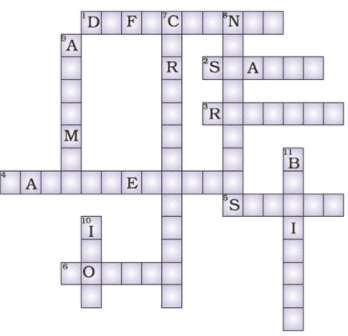 Across
Across
0.02em;">1. Lack of nutrients in our diet over a long period causes these diseases (10)
0.02em;">2. Rice and potato are rich in this type of carbohydrate (6)
0.02em;">3. Deficiency disease in bones making it become soft and bent (7)
0.02em;">4. The diet that provides all the nutrients that our body needs, in right quantities, along with an adequate amount of roughage and water (8, 4)
0.02em;">5. Deficiency disease with bleeding gums (6)
0.02em;">6. Disease caused due to deficiency of iodine (6)
0.02em;">Down
0.02em;">7. Starch and sugar in our food are rich in this type of energy-giving nutrient (13)
0.02em;">8. The term is given to the useful components of food (9)
0.02em;">9. The disease caused by a deficiency of iron in diet (7)
0.02em;">10. Green leafy vegetables, liver and apples are rich in this mineral (4)
0.02em;">11. Deficiency disease caused due to lack of vitamin B in the diet (8)
0.02em;">
Q20: Observe the items given in Fig. 2.2 carefully and answer the questions that follow.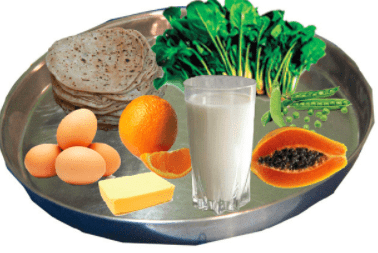
(a) Food item rich in carbohydrates is (i) ______
(b) Egg is a rich source of protein, the mineral (ii) ______and vitamin (iii) ______
(c) (iv) ______is a rich source of fat.
(d) Milk provides ______(v) ______vitamin D and ______(vi) ______(mineral).
(e) ______(vii) ______(fruit) is a rich source of vitamin A.
(f) Spinach is a good source of the mineral__(viii) ______
(g) Both eggs and ______(xi) ______are rich in ______(x) ______
 View Answer
View Answer 
(a) (i) chapati
(b) (ii) phosphorus (iii) D
(c) (iv) Butter
(d) (v) protein (vi) calcium
(e) (vii) Papaya
(f) (viii) iron
(g) (ix) peas (x) proteins
Q21: SNAKES AND LADDERS
Make a board-game just like ‘snakes and ladders’ with 10 x 10 grid boxes.
The mouth of the snake will represent the faulty food habit or faulty method of cooking. Its tail will represent the deficiency disease caused or loss of any nutrient in food.
Similarly, the box at the base of a ladder will represent healthy food habit or a healthy method of cooking. Its upper end will represent the beneficial effect of that habit. An example is given as Fig. 2.3. Complete the board and play with your friends.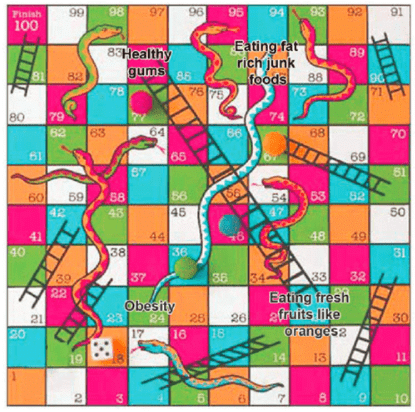
 View Answer
View Answer 
The terms to be put at the mouths and tails of snakes at different grid numbers are as follows: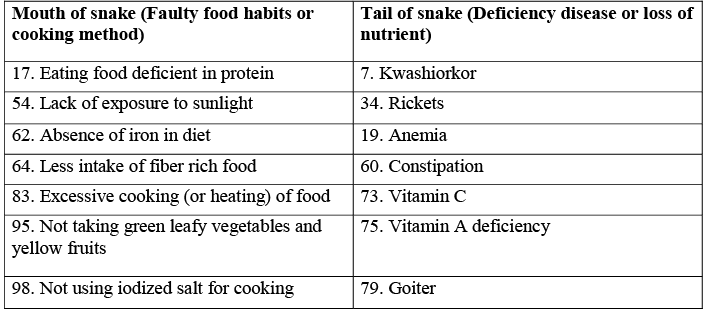 The terms to be put at the base and the upper end of the ladders at different grid number is as follows:
The terms to be put at the base and the upper end of the ladders at different grid number is as follows:
|
72 videos|142 docs|90 tests
|
FAQs on NCERT Exemplar Solutions: Components of Food - Science Olympiad Class 6
| 1. What are the main components of food? |  |
| 2. Why are carbohydrates important for our body? |  |
| 3. How do proteins benefit our health? |  |
| 4. What is the role of fats in our diet? |  |
| 5. Why are vitamins and minerals necessary for the body? |  |


